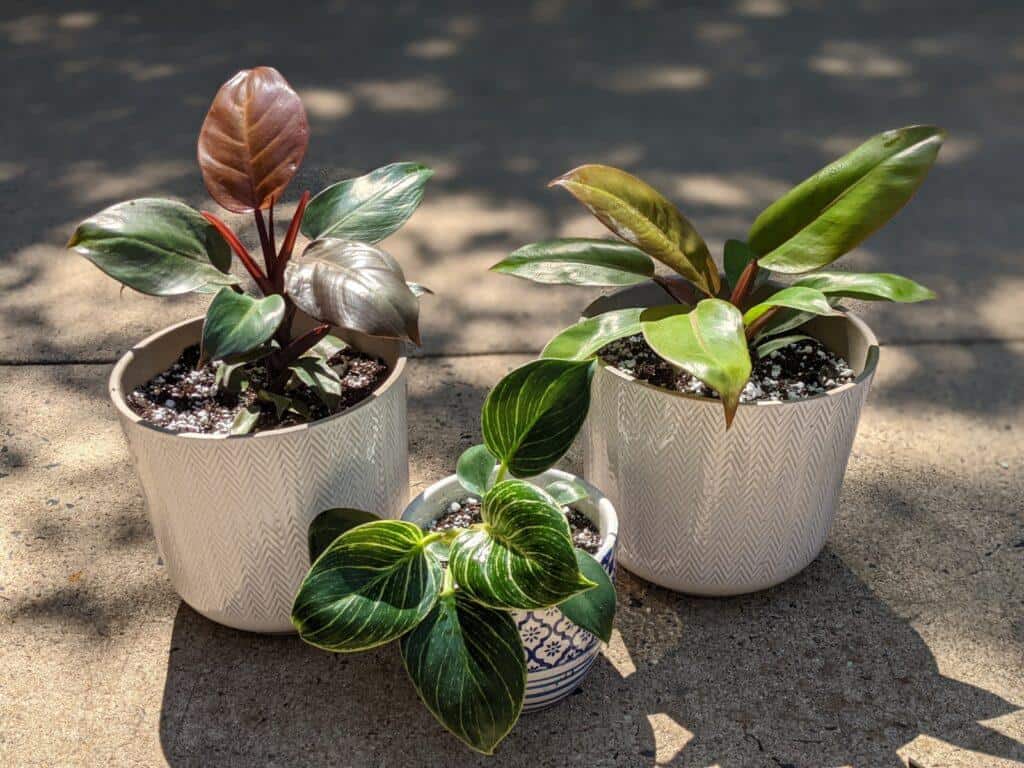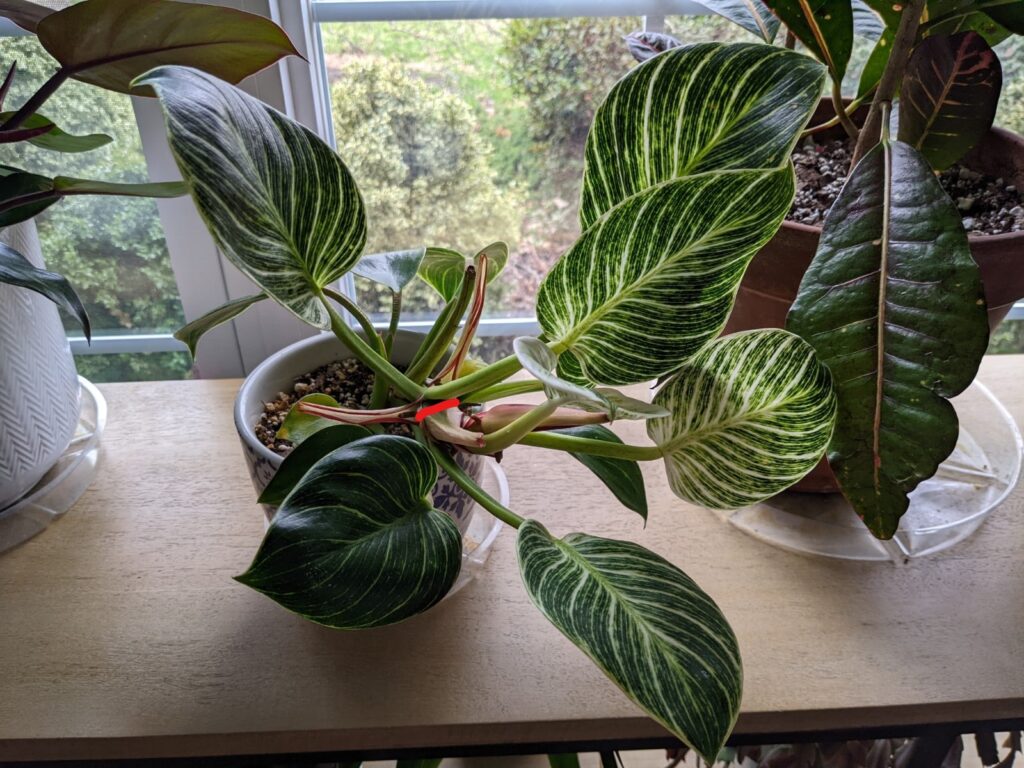Help! Philodendron Birkin Losing Variegation
I have seen a lot of people asking about their Philodendron Birkin losing variegation on plant forums lately. To help, I wrote this post to cover some scenarios in which you might encounter green Birkin leaves. I will also cover some recommendations to address losing variegation so you can make sure your plant stays beautiful and healthy.
Back to topPhilodendron Birkin Basics
Philodendrons are a very popular houseplant. They come in a vast variety of shapes and sizes. Philodendrons, including the Birkin, can often be found at home improvement stores and nurseries nowadays. Philodendrons vary in leaf size, leaf shape, and leaf color but their basic care is essentially the same. The Birkin is a hybrid philodendron, or self-heading, which just means that it’s not vining like other philodendrons. The leaves are green and white or cream-colored striped. They do well in an east-facing window or west-facing window where it will get moderate light.
| Light Needs | Watering Needs | Soil Needs | Fertilizing Needs |
| Moderate to bright indirect light. | The top inch of soil should be dry before watering. | Well draining potting soil. | A few times per growing season. |
Philodendron Birkins are somewhat quick-growing. I have had mine for about three years. During the growing season, it seems like it puts out a new leaf every week or so. Below is a picture of a few of my Philodendrons, including my Birkin from a repotting post I did a while back. All varieties of Philodendron are not safe for your dog or cat to ingest, so keep them out of reach.

Is Your Philodendron Birkin Losing Variegation?
Don't panic. First, let's make sure your Philodendron Birkin is in fact losing its variegation. As you can see from the photo above the older leaves lower toward the base of the plant appear darker green and like they have fewer white lines. This is completely normal. So if this is what's happening to your plant, breathe a sigh of relief. If you're looking for ways to prevent this, unfortunately, you're out of luck.
If your Philodendron Birkin has large patches of just green on its newly formed leaves, then it is losing its variegation. This loss of variegation is also called reverting if you want to google further. The Birkin was made from propagating a chimeric leaf of another Philodendron plant. This chimeric leaf displayed the white lines that we recognize as Birkins but the leaf came from a Philodendron with green mature leaves. If your Birkin starts putting out green leaves or leaves with patches of green, then it is beginning to revert to that original plant.
Back to topHow to Stop Birkin From Reverting
If you have identified that your Philodendron Birkin is reverted, you need to cut the plant back to the last fully variegated leaf. Philodendrons are pretty forgiving and most will begin to grow new leaves after being cut back like that. If you have more than one reverting leaf, you must remove all reverted leaves. I don't have an example of a reverting leaf myself but have illustrated where to cut if the top leaf were reverting. If it's the growing season then you can expect to see signs of a new leaf in a week or two.

Back to top
How to Prevent Philodendron Birkin From Reverting
Philodendron Birkin Light Requirements
If your Philodendron Birkin has reverted or generally does not have very vibrant white stripes, then it may not be getting adequate light. They require moderate to bright indirect light. Moderate to bright light will come through an east or west-facing window. Bright light comes though your south-facing window. However, bright indirect light means it gets some shading from trees outdoors or from a sheer curtain.
The most common problem I see for a lot of plant owners is lack of light. Unless your Philodendron is outside or showing signs of being burnt it's probably safe to assume it is not getting enough light.
How to Fix Light Issues
Light issues are hard to quantify and hard to describe. Yes, I can say the sun gives moderate light in east and west windows and bright from the south, but there are a lot of other factors. How close to the window is your plant? Do you have curtains or shades? Are there trees or buildings that block some of the light?
The best tool I have found for measuring light and tracking how much a certain spot receives over many days is the Smart Plant Monitor. To me it's the best light monitor for hobbyist. I like that it tracks the light hourly so it measures the intensity of the sun rays and the how many hours of sun accumulated. I did a whole write-up here.
If you suspect your plant needs more light, then try moving it to a sunnier window. It also helps to be closer to the window as well. If you don't have those options you could consider adding a grow light.
Fertilizing Issues Can Cause Reverting
Nutrients can be both over and underdone. Reverting Philodendron Birkin leaves typically a sign of under fertilization. Overfertilized plants are more likely to exhibit slow growth and maybe wilting. Typical houseplant fertilizers have a balanced ratio of nitrogen, phosphorous, and potassium, or n-p-k, which you see on the label of plant fertilizer. Reverting leaves may be a symptom of a lack of nitrogen or phosphorous. Nitrogen helps promote healthy foliage growth.
If you have a fertilization issue your plant may look unhealthy and droopy on all the leaves, not just the reverting one. You can use soil rapitest which allows you to test for ph and each nutrient individually. It's the only way to be totally sure you have a nutrient deficiency, and if you have a lot of plants it's a good investment.
How to Fix Fertilization Issues
An overfertilized Philodendron Birkin, be flushed by repeatedly watering the soil with large amounts of water. You may even want to remove the plant from its pot because you don't want to end up overwatering either. Removing from the pot will let it dry out better.
To fix an under fertilized plant you will need to fertilize it. Water-soluble or liquid fertilizers work best for quicker absorption. If you don't opt for a soil rapitest that I linked earlier, it would be best to stick with a balanced fertilizer that has the same number in the n-p-k ratio. However, if you know for sure you have either nitrogen deficiency, then get a high nitrogen fertilizer. Whatever you do, follow the instructions on the fertilizing product. Some fertilizers require dilution or that you water the plant beforehand.
Water Issues Can Cause Reverting
Both over and underwatering could cause your Philodendron Birkin to lose variegation however it is far less likely to be the culprit compared to the light and fertilization. The best way to tell if there are water issues is to use a soil moisture meter. Something simple like this soil moisture meter will do the trick. You can also use your finger.
How to Fix Water Issues
If you are underwatering, it's pretty straightforward. You either want to water more frequently or water more deeply. Don't overdo it though, you could go too far the other way. The leaves that have lost variegation on your Philodendron Birkin will not regain their color though. If you have been underwating and now the water just runs through your plant, you may need to water from the bottom. That just means to stick your plant pot in a bowl or the sink with water and the soil and roots soak up water from the base of the plant.
If you have overwatered, it's more complicated to fix. The first thing you want to do is carefully remove your Philodendron Birkin from its pot. That will let the root ball and soil dry more quickly. Overwatered roots are very tender and vulnerable, so you have to be careful and clean. Let the root ball has dry enough to handle, you need to inspect the roots for rot. Rotten roots appear brown and feel mushy. If you find rotten roots you need to cut them away with a clean sharp knife. Then you can repot your Birkin in new soil and hope for the best. I have a whole post dedicated to fixing an overwatered plant if you want to follow along in more detail.
Hopefully, this helps explain the cause or causes of your Philodendron Birkin losing variegation and now you can begin your journey to fix it. Have any questions? Post them in the Comments section below.
Back to top
Add new comment